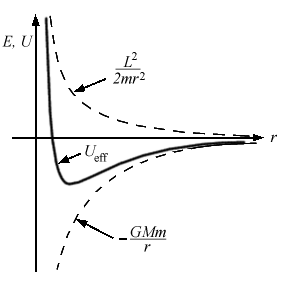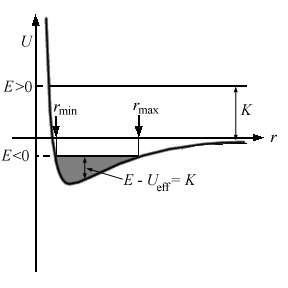E = K + Uwhere K = 1/2 mv2. But what is the potential energy appropriate to our planetary system?
Remember that only differences
in potential energy are important. If we raise a mass at the surface
of the Earth by a distance h, we do work against gravity
| r2 | |||
| W = | F . dr | = -mgDr = -mgh | |
| r1 |
and the negative of this work is the change of potential energy
Raising a mass from the floor to the desk raises the potential energy by mgh, and raising it by the same height from the desk to a shelf also raises U by mgh -- only the difference DU matters. Thus, we are free to choose our zero of potential energy anywhere we wish.
r2 DU = -W = - F . dr = mgh r1
We will choose DU
= 0 at r = infinity,
which means the potential energy anywhere
in the system is negative. Now
what is the potential energy at position r?
We first place a test mass of mass m
at infinity, and then move it radially inward to distance r
from the center (from mass M)
with the force of gravity acting all the way along this path. We
have
| r | GMm | ||
| U = - | - |
|
r .dr |
| inf |
|
which evaluates to
| r | dr | GMm | | r | |||
| U = GMm |
|
= - |
|
| | ||
| inf |
|
|
| inf |
or finally,
U = -GMm/r (Gravitational potential energy)As advertised, the potential energy is negative for any r, and approaches zero as r approached infinity. The total energy for an elliptical orbit, then, is
E = K + U = 1/2 mv2- GMm/rwhere we have used the vis viva equation (which is why this is valid only for elliptical orbits), and we have made the approximation that M >> m.
= 1/2 mG(M+m)[2/r- 1/a] - GMm/rE = - GMm/2a
Note that the total energy is negative, and is just a constant. Thus, energy is conserved along the orbit, as of course it must be.

